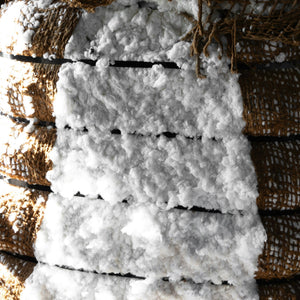How the Eco Score Is Driving Sustainability in France’s Fashion Industry
It’s one thing to enact laws, policies, and regulations. It’s another thing entirely to enforce, comply, and meet those standards.
When the French government introduced the Eco Score initiative as part of its Anti-Waste and Circular Economy Law (AGEC), it aimed to transform production and consumption habits across sectors in practical, actionable ways—in alignment with sweeping legislation rollouts like the Green Claims Directive (GCD), part of the EU Green Deal.
Even though the initiative, requiring apparel brands to disclose their products' environmental impact through a standardized numerical score, is set to become mandatory by 2026, the need for change began decades ago.
It was an epoch in which France’s fashion brands relied on voluntary environmental claims, independent certifications, internal lifecycle assessments (LCAs), and investor-focused CSR reporting that varied wildly in quality, transparency, and on-the-ground, consumer-level and environmental impact.
Cut to today’s urgent driving issues like high levels of textile waste and overproduction, consumer confusion and skepticism over vague sustainability claims, and the need for harmonized, science-based comparisons across products and brands. In this context, developing an Eco Score for each product couldn’t come at a better time for ESG fashion brand managers looking to meet regulatory requirements while also differentiating themselves in a competitive market.
In the following sections, we'll explore how ESG managers can navigate this new landscape, turning regulatory compliance into a catalyst for innovation and sustainability in the fashion industry.
Understanding the Eco Score: A Tool for Responsible Consumption
“Everything that can be measured can be optimized.”
That’s not a quote by a scientist or mathematician — rather, it’s what Xavier Prudhomme, General Manager of the Beaumanoir Group (Bonobo), sees as a benefit of the Eco Score adoption. Prudhomme emphasizes the dual role of the Eco-score as both a transparency mechanism for consumers and a catalyst for internal sustainability enhancements:
“This logic also underlies the mobilization of our teams for the implementation of environmental labelling, which we see as much as an information tool for our customers as a lever for continuous improvement.”
So, what is the Eco Score, and how does it work? Before we discuss the structure of the unique labeling system and why its implementation promises a more robust, tactical way to report real change, let’s quickly consider the problems that the Eco Score aims to solve.
Issue #1: Voluntary Environmental Claims (Leading to Greenwashing)
Brands often made environmental or ethical claims (e.g. “sustainable,” “eco-friendly,” “green materials”) without standardized definitions or third-party verification for each label. This led to:
-
Greenwashing concerns
-
Lack of consumer trust
-
Inconsistent criteria across the market
How the Eco Score transforms the issue
-
Encourages all brands to use the same impact methodology, reducing fragmentation.
Issue #2: Use of Independent Certifications (Leading to Opaque Supply Chains)
Some brands relied on labels like GOTS (Global Organic Textile Standard), OEKO-TEX®, or Fair Trade. Still, adoption was inconsistent, and not every label or certification covered the full lifecycle of a product or supply chain transparency.
How the Eco Score transforms the issue
-
Creates a government-endorsed, standardized score based on LCAs, reducing room for misleading claims.
-
Forces brands to collect and disclose upstream data from Tier 2 and beyond, improving traceability.
Issue #3: Internal Lifecycle Assessments (Leading to a Lack of Comparability)
Larger or sustainability-focused companies (e.g. Patagonia, Veja) conducted lifecycle assessments or carbon footprints internally or with partners. However, results were rarely public, were not comparable between brands, and proved difficult for consumers to interpret.
How the Eco Score transforms the issue
-
Provides a uniform rating system through a score for each product, enabling consumers to compare sustainbility claims across brands.
Issue #4: CSR Reporting Outcomes Disconnected (Leading to Disengaged Consumers)
Many brands published Corporate Social Responsibility (CSR) reports, but these were aimed at investors or NGOs, not consumers, and often lacked product-level detail.
How the Eco Score transforms the issue
-
Setting a well-defined score for each product makes sustainability information simple and accessible at the point of purchase.
Now let’s examine how it works, what it measures, and data sources that make this score for each product as robust and consequential as it promises to be for ESG managers.
How the Eco Score Is Calculated for Fashion Products
Officially termed the "Environmental Cost" (Coût Environnemental), France’s “Eco Score” label comprehensively assesses a garment's environmental impact throughout its entire lifecycle. It’s rooted in in the Climate and Resilience Law (Loi Climat et Résilience) and offering transparent and standardized information about the sustainability of textile products remains its ultimate aim.
“[The scoring system] forces us to think differently, to think more about the style of the product, avoid waste, to transport differently, maybe using shipping by sea [instead of planes].”
It’s worth noting that this development adds another layer of complexity to an already demanding role for ESG managers in the fashion industry. Their day-to-day demands focusing on tasks like:
-
Mapping intricate supply chains.
-
Collecting data from multiple tiers of suppliers.
-
Ensuring compliance with evolving regulations like the Corporate Sustainability Reporting Directive (CSRD) and Double Materiality Assessments.
Balancing these responsibilities while demonstrating the return on investment for sustainability initiatives is a formidable challenge, especially for smaller brands with limited resources.
It’s a point that Séverine Mareels, Sustainable Development Director at Okaïdi acknowledges as she says, “[The scoring system] forces us to think differently, to think more about the style of the product, avoid waste, to transport differently, maybe using shipping by sea [instead of planes].”
However, Okaïdi, a children's clothing brand, took a step in the right direction by integrating the Eco Score into 10% of its products — so every little bit counts and the effort toward full-scale integration is, by the very nature of the Eco Score, intended to be an interactive process, not an overnight overhaul.
Her words also reveal another need: to compete and comply, brands must get innovative. It would help brands to remain open to change, which means re-evaluating their design and logistics strategies to minimize environmental impact.
Using her words as a guide, ESG managers need to see compliance as an opportunity. And the way “in” to this opportunity is through a focus on what it measures and how. We’ll look at that next and help spotlight brands already working to implement operational infrastructure for its measurement and reporting.
More Than a Label: What the Eco Score Measures Beyond Raw Materials to Packaging
So, despite challenges ESG managers face, the Environmental Cost labeling system presents an opportunity to drive meaningful change. By proactively engaging with suppliers and integrating sustainability metrics into product development, brands can meet regulatory requirements and differentiate themselves in a competitive market.
Brand spotlight: Lagoped
-
Lagoped, a French outdoor apparel brand, calculated Eco Scores by collaborating with Peftrust, a SaaS platform specializing in environmental impact assessments.
-
For instance, their EVE jacket received a European Eco Score of 2,389 points, significantly lower than the reference product's 12,251 points, indicating a reduced environmental footprint.
-
In April 2024, Lagoped made all its "Ecobalyse" scores available online, communicating to consumers its commitment to transparency and traceability.
To calculate the Eco Score, 16 environmental indicators, encompassing various stages and factors such as the following lay a standard base for all brands:
-
Raw material extraction — Assesses the environmental footprint of sourcing materials, considering factors like land use and biodiversity impact.
-
Manufacturing processes — Evaluates energy consumption, water usage, and chemical use during production.
-
Transportation — Accounts for emissions and energy use associated with moving materials and finished products.
-
Packaging — Considers the environmental impact of packaging materials and their recyclability.
-
End-of-life — Analyzes the product's recyclability, biodegradability, and potential for reuse or repurposing.
-
Carbon emissions — Measures the total greenhouse gas emissions throughout the product's lifecycle, from raw material extraction to disposal.
Additionally, the Eco Score incorporates factors such as microfiber pollution, sustainable agriculture practices, and brand initiatives promoting overconsumption. This holistic approach can help ensure that the score reflects the product's immediate environmental impact and its broader ecological footprint.
Julia Faure, Co-founder of Loom, warns against the gap between the hypothetical promises of regulation and the effects it may result in. Faure critiques the current financial incentives, suggesting that the low cost of eco-contributions may not be sufficient to drive substantial changes in manufacturing practices.
“Brands already have to pay eco-contributions on products... but the contribution for textiles is just six cents per item, meaning that companies often prefer to just pay it rather than overhauling their manufacturing methods.”
Each environmental impact category carries a specific weight in the overall score, reflecting its relative importance. For instance, carbon emissions might have a higher weight than other indicators, emphasizing the urgency of addressing climate change.
For brands seeking to calculate their products' Eco Scores, the French government has introduced the Ecobalyse platform — a free online tool designed to estimate the environmental impact of textile and food products. This platform aids in ensuring consistency and transparency in the scoring process.
From Data to Decision-Making: How the Eco Score Methodology Works
A significant reason the Eco Score is so accessible and, relative to other regulatory requirements, is that it’s simpler to initiate. The foundation of the Eco Score's measurement methodology lies in robust environmental data — and ESG managers can begin with these data sources to calculate scores.
The Ecobalyse platform, which we looked at above, is an example. Another is the Agribalyse, developed by the French Agency for Ecological Transition (ADEME). It’s a comprehensive public database that provides environmental indicators for agricultural and food products based on LCAs.
Beyond the core environmental indicators, the Eco Score incorporates a "bonus-malus system" to adjust scores based on specific product attributes and practices:
-
Bonuses: Awarded for positive environmental practices, such as using organic materials, implementing eco-design principles, or ensuring product durability for consumption.
-
Maluses: Applied for negative impacts, including using hazardous chemicals, poor recyclability, or contributing to microfiber pollution.
This system incentivizes brands to adopt sustainable practices by directly influencing their products' Eco Scores.
Brand spotlight: agnès b
-
The French fashion house agnès b. is actively preparing for the Eco Score's implementation by integrating environmental labeling into its Corporate Social Responsibility (CSR) strategy.
-
The brand uses GOTS-certified organic cotton to enhance transparency and consumer trust.
-
Alessandra Lobba, the brand's CSR and Sustainable Development Director, emphasized the importance of supply chain data collection and collaboration with suppliers to achieve comprehensive traceability and impact measurement.
5 Challenges in Calculating Scores for Different Product Categories
Implementing France's Eco Score across the diverse landscape of fashion products presents several challenges. These complexities stem from variations in materials, product designs, and manufacturing processes, affecting the accuracy and consistency of environmental impact assessments.
#1: Data Gaps in Life Cycle Assessments (LCAs)
Life Cycle Assessments are foundational to calculating Eco Scores, yet comprehensive and high-quality data are not always available for all product categories. For instance, while data on cotton production might be extensive, information on newer or less common materials can be sparse. This lack of data can lead to less accurate or representative Eco Scores for certain products.
#2: Variability in Product Complexity
Fashion products vary widely in complexity — from simple t-shirts to multi-material jackets or embellished garments. To assess the environmental impact of more complex items you'll need detailed information on each component and its production process. This complexity can make it challenging to produce accurate and comparable Eco Scores across different product types.
#3: Inconsistencies in Methodological Approaches
Different methodologies or assumptions used in LCAs can result in varying Eco Scores for similar products. For example, choosing data sources, system boundaries, or impact assessment methods can influence the outcomes. Such inconsistencies can hinder the comparability of Eco Scores across brands or product categories.
#4: Integration of New Environmental Indicators
The French Eco Score aims to incorporate additional environmental indicators, such as microplastic pollution and biodiversity impact, which are not always included in traditional LCAs. Integrating these new indicators requires the development of standardized measurement methods and data collection processes, which are still evolving.
#5: Alignment with European Standards
France's Eco Score initiative seeks to align with the European Union's Product Environmental Footprint (PEF) framework. There are distinct differences between national and EU methodologies, which can create challenges for brands operating across multiple markets. So, ensuring consistency and compliance with both standards requires careful navigation.
Setting a Global Standard: Will the Eco Score Model Expand Beyond France?
As the system moves toward mandatory implementation by 2026, questions arise about its potential adoption beyond French borders.
While the Score is currently specific to France, its comprehensive approach to environmental assessment has sparked interest internationally. The growing emphasis on transparency and environmental accountability in the fashion industry may drive other countries to explore similar labeling initiatives.
And, like the current challenges to adoption of the Eco Score across production categories, the Eco Score model presents several challenges when it comes to global expansion:
-
Data standardization: Ensuring consistent and reliable data across diverse supply chains is complex.
-
Regulatory differences: Varying environmental regulations and standards across countries can complicate harmonization efforts.
-
Industry readiness: Brands may face difficulties adapting to new assessment methodologies, particularly those with limited resources.
Despite these challenges, the Eco Score's emphasis on lifecycle analysis and transparency positions it as a potential model for global environmental labeling in the fashion industry. For ESG and sustainability managers in fashion, sustainability isn’t just a department — it’s a business strategy, and tools like the Eco Score are helping lead the way.





